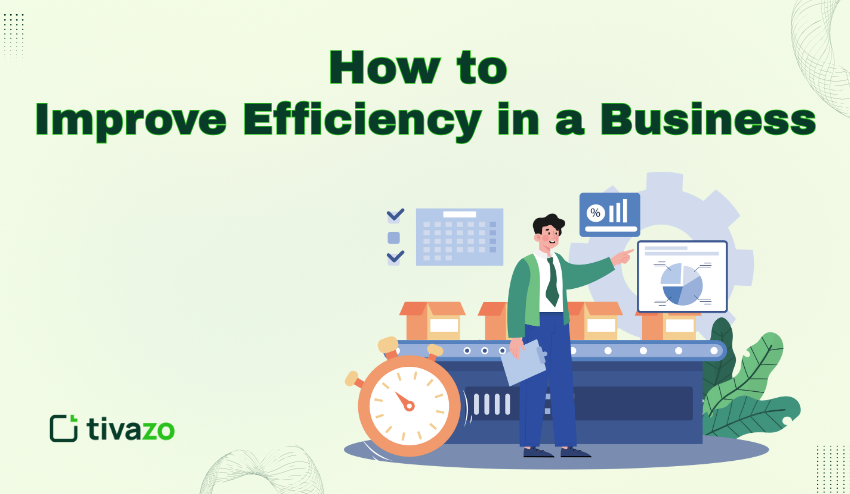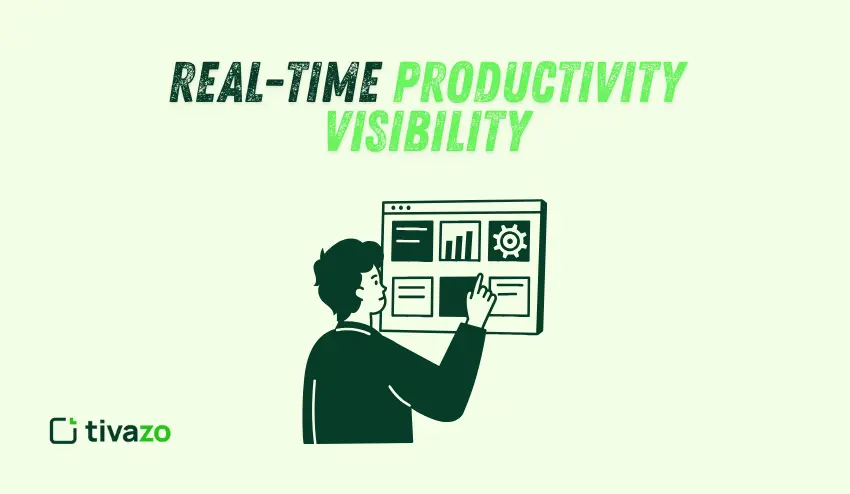Running a business in the modern world is more difficult than ever before. Prices continue to increase, competition is intensifying and customers are demanding quicker service. The only way to remain ahead is to ensure that each hour, each dollar and each effort is counted. This is why the necessity to learn how to improve efficiency in a business is not optional, it is crucial.
Efficiency is what differentiates between businesses that fail and those that grow. Once you eliminate wastage of time, streamline operations and utilize your resources effectively, profits will be the natural outcome. It does not take more people or higher budgets to grow, it takes smarter systems.
I will give you some practical strategies that I have applied and have seen work in real businesses. By the end, you will have a clear understanding of where to make an effort in order to increase efficiency and start seeing profits grow fast.
What does improving efficiency mean in business?
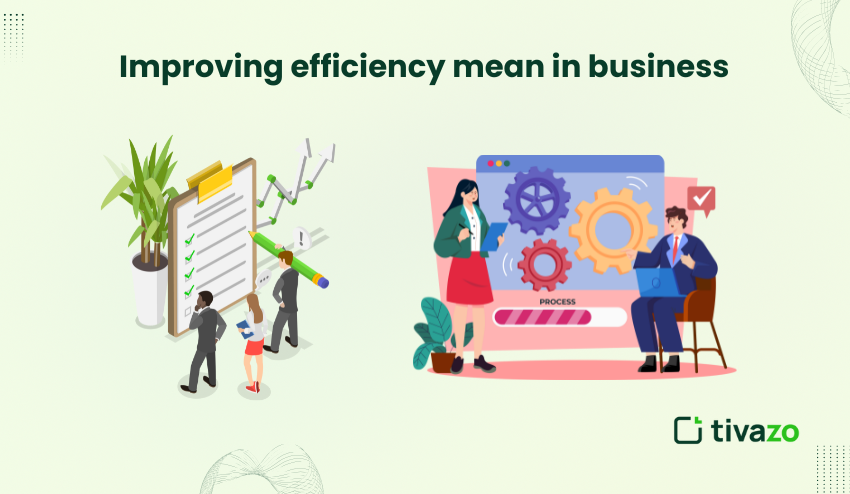
What does efficiency mean? Before we explore the strategies, it is important to define what efficiency is. Efficiency is not the same as productivity and many business owners mix the two. Productivity is output, how much you produce. Efficiency is the degree to which you utilise resources such as time, money, and staff to get that output.
Consider two firms that each make 100 sales in a month. When one team requires twice the number of hours, twice the number of people and more money to achieve the same outcome, then they are less efficient. The more effective business is less resourceful in achieving the same or better results.
Understanding this difference is key if you want to know how to improve efficiency in a business. An exclusive focus on productivity will result in burnout and increased costs. However, an emphasis on efficiency will result in achieving the same or greater results using fewer resources that can be used to reinvest in growth.
Why Improving Efficiency Matters for Profit Growth
Efficiency does not only mean the saving of time; it directly impacts profits. When you understand how to improve efficiency in a business, you reduce unnecessary costs and deliver faster results. This automatically means increased margins and better consumers.
This way of thinking about it: wasted time = wasted money. When your team uses several hours doing something that they could streamline or automate, you waste time that could have been directed toward other activities. By applying smart business efficiency strategies, you make sure every dollar and every hour drives real results.
The other advantage is agility. An efficient firm is one that adjusts to the market changes quickly. Be it customer need, the emergence of new competitors or increasing costs, an efficient business can be a step ahead. That’s why leaders who want to improve business performance focus on efficiency as a foundation.
Lastly, efficiency earns trust from customers. Faster Delivery, fewer errors, and superior service all bring loyalty. Customer notices the difference when your operations are lean. Such loyalty transforms into repeat customers and long-term profit gains. If you’re looking to boost workplace efficiency, this is where the payoff truly shows.
10 Practical Ways to Improve Efficiency in a Business
Efficiency doesn’t have to be complicated to improve. These ten actionable steps will help you boost workplace efficiency, streamline operations, and improve business performance. The steps are practical and ready to be implemented.
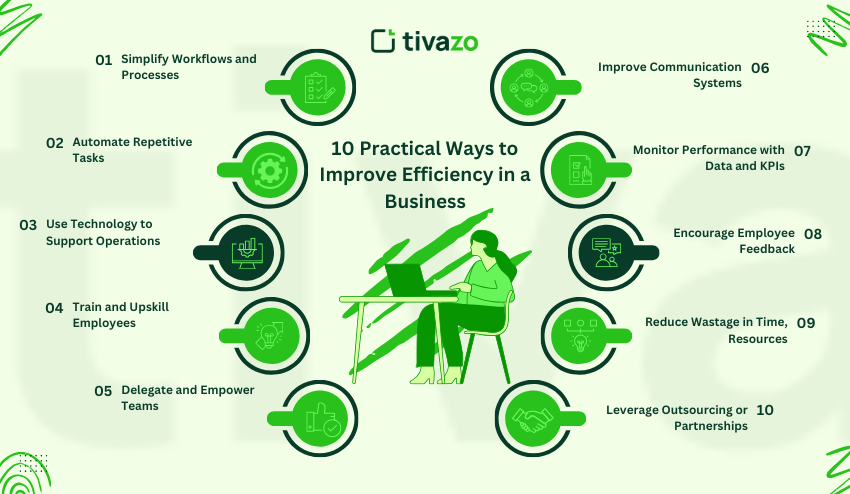
1. Simplify Workflows and Processes
Simplification of workflows is one of the fastest methods of enhancing efficiency within a business. Most businesses possess obsolete processes that delay business processes. Creating too many approvals, a lack of clarity and redundancy in tasks all consume time and money.
Develop process maps or standard operating procedures (SOP) of key activities — ideally using process mapping software to visualize and optimize each step. When everyone is aware of what is expected of him or her and when, the confusion is reduced and speed is enhanced. Streamlined workflows are a cornerstone of business efficiency strategies.
2. Automate Repetitive Tasks
Task Automation is an efficient instrument. Activities such as invoicing, appointment reminders, or follow-up emails consume hours that could be redirected toward strategic initiatives, with email campaign management services standing out as a critical driver of customer connection and ROI.
One such example was my assistance to a service company to apply automated scheduling and client updates. This minor modification reduced administrative time by 30 percent and gave the team more time to concentrate on revenue-generating activities. Automation is one of the most effective business efficiency strategies to boost workplace efficiency.
3. Use Technology to Support Operations
The appropriate technology can change the way your business functions. Cloud platforms, CRMs, and project management tools will centralize the communication and minimize redundancy in work efforts. n industries with complex customer interactions, the right technology can make an even bigger impact. For example, in the automotive repair industry, shops now use auto repair shop CRM to automate post-service follow-ups and run targeted marketing campaigns with little to no manual effort.
When your team is constantly navigating to find the latest updates or are trying to use several tools, efficiency is compromised. Investing in technology that aligns with your processes is a key step in how to improve efficiency in a business and improve business performance.
4. Train and Upskill Employees
Your human resource is your best asset. Lack of training will cause inefficiency and more errors occur. Upskilling on a regular basis enables employees to be competent and confident and help avoid skill issues.
Employee cross-training also means that when one employee is not available, workflow does not get stalled. A well-trained team is essential in any set of business efficiency strategies and helps you consistently boost workplace efficiency.
5. Delegate and Empower Teams
Micromanagement kills productivity. Effective delegation will enable employees to become more proactive.
When assigning, make roles and performance clear. One of the practical methods to boost the efficiency of a business and at the same time boost morale and engagement is to empower the employees to make their own decisions without having to be supervised.
6. Improve Communication Systems
Ineffective communication is an unseen efficiency killer. Long email chains and piecemeal updates lead to lost time and inaccuracies. This is especially true when teams struggle with large or confidential documents, where using a dedicated secure file sending service can replace insecure email attachments and prevent costly delays.
Shared tools such as Slack, Microsoft Teams, or Asana allow teams to keep track of each other and eliminate unnecessary time spent. Enhancing communication is a proven method to boost workplace efficiency and improve business performance.
7. Monitor Performance with Data and KPIs
You can not improve what you do not measure. Establish specific KPIs of efficiency, such as turnaround time, idle time, output per employee, or cost per task.
Monitoring these measures will enable you to know the bottlenecks and work on them in a timely manner. Using data-driven insights is one of the strongest business efficiency strategies to improve efficiency in a business.
8. Encourage Employee Feedback and Innovation
Frontline employees usually notice inefficiencies even before the management does. Create outlets through which employees can provide suggestions and reward common sense ideas that save time or resources.
This strategy does not only increase the efficiency in the workplace, but also develops a culture of continuous improvement. Listening to your team is a simple but powerful way to improve business performance.
9. Reduce Wastage in Time, Resources, and Costs
Efficiency is a matter of waste elimination. Excessive production, useless meetings and subscriptions are resource-wasting.
They implement lean practices, constantly assess how they are using resources and eliminate anything that does not add value. One sure way of increasing efficiency in a business is to reduce wastage, and this translates to increased profits.
10. Leverage Outsourcing or Partnerships
Not all work should be done internally. Outsourcing non-core functions such as payroll, IT or customer service can be cheaper and time-saving.
Outsourcing to specialized providers enables your staff to do what they do best. Outsourcing is one of the smartest business efficiency strategies to boost workplace efficiency and improve business performance. The business will find alot of advantages from outsourcing.
Common Mistakes Businesses Make When Improving Efficiency
Knowing how to improve efficiency in a business is valuable, but many companies go about it the wrong way. Efficiency does not mean working at a lower cost or faster. When the method is incorrect, then the outcome is wasted effort, frustrated employees, and reduced profits.
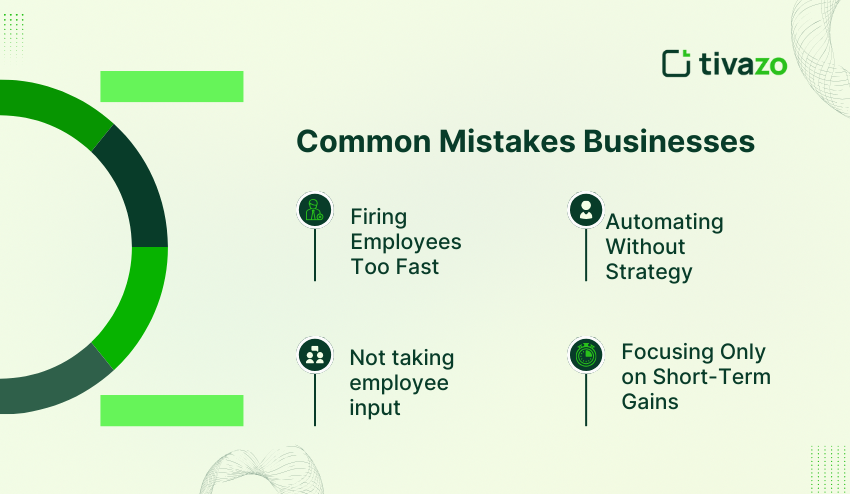
Here are the most typical errors to avoid:
1. Firing Employees Too Fast
In efforts to be more efficient, some businesses attempt to cut down on the number of employees. Although this reduces the costs in the short run, it can always backfire. The other workers get overworked, and morale and productivity decline. Efficiency will be achieved through smarter systems rather than through reduced numbers.
2. Automating Without Strategy
Automation is one of the best business efficiency strategies, but too much automation can create confusion. Without proper integration of tools or lack of clearly defined processes, the business wastes a lot of time correcting mistakes instead of saving time. Automation should always be based on needs.
3. Not taking employee input into consideration
Employees are in the best position to know where bottlenecks are. Failure to take their feedback into consideration may result in changes that seem good on paper but will not work in the real world. Involving staff in efficiency decisions not only helps boost workplace efficiency but also increases engagement.
4. Focusing Only on Short-Term Gains
Other leaders introduce short-term solutions that do not take into account sustainability. As an example, forcing the staff to work overtime may enhance the short-term output but will negatively affect retention and performance in the future. Real business efficiency strategies aim for lasting improvement.
It is also as important as avoiding these mistakes as much as taking the right steps If your goal is to improve business performance in a meaningful way, efficiency efforts must balance cost-saving with employee well-being and customer satisfaction.
How to Measure Business Efficiency and Profit Growth
The initiation of changes is just one part of the task To determine whether your efforts are bearing fruits, you have to measure results. Tracking the right metrics ensures that your business efficiency strategies are paying off and showing clear improvements.
Key Metrics to Track
- Output per Employee
- Determines the amount of work done by each employee in a given time frame
- A rise in this number shows you’ve found ways to boost workplace efficiency.
- Turnaround Time per Project
- Tracks the speed of task or project completion
- Faster delivery usually means you’ve successfully learned how to improve efficiency in a business
- Cost per Unit or Cost per Task
- Reveals the cost of producing a single or completing a single task.
- Reduced expenditures without compromising quality are signs of increasing the efficiency.
- Profit Margins
- The efficiency test is the profitability.
- Margins ought to increase with a steady decline in waste and an increase in output.
Continuous Monitoring
Efficiency is not a one-time project. Businesses that thrive develop a culture of monitoring and enhancing on a regular basis. A frequent review of KPIs can help you identify bottlenecks in the business, make the right adjustment, and keep the progress.
When you focus on these measures, you’ll know exactly whether your steps to improve business performance are making an impact. What is more important, measurement helps to ensure that efficiency improvements are directly converted to profit growth.
Conclusion
Learning how to improve efficiency in a business is not about working harder—it’s about working smarter. By reducing workflows, automating processes, training employees and empowering your team, you can develop a system that saves time, cuts costs and raises profits.
Efficiency has a direct effect on your bottom line. Companies that focus on business efficiency strategies consistently boost workplace efficiency and improve business performance. Focused, small-scale changes have the potential to generate quantifiable outcomes, such as shorter project delivery time or increased customer satisfaction.
Start today by selecting one of these strategies in this guide and putting it into practice. Measure the outcomes, make corrections, and capitalize on your achievements. Every step you take combines into more powerful operations and sustainable growth.
Efficiency is a process. The more you concentrate on it, the better your business will perform and the sooner you will notice that profits are increasing.
